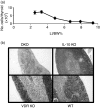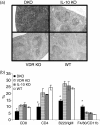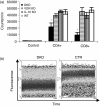Vitamin D receptor is required to control gastrointestinal immunity in IL-10 knockout mice
- PMID: 16476050
- PMCID: PMC1782241
- DOI: 10.1111/j.1365-2567.2005.02290.x
Vitamin D receptor is required to control gastrointestinal immunity in IL-10 knockout mice
Abstract
The vitamin D receptor (VDR) is a nuclear receptor expressed in a number of different cells of the immune system. This study was performed to determine the effect of VDR deficiency on immune function and inflammation of the gastrointestinal tract in a model of inflammatory bowel disease, namely interleukin-10 (IL-10) knockout mice. IL-10 knockout mice were generated which either could or could not respond to vitamin D (double IL-10/VDR knockout; DKO). The distribution and function of lymphocytes in both the primary and secondary lymphoid organs were compared and determined as a function of the severity of intestinal inflammation. DKO mice had normal thymic development and peripheral T-cell numbers at 3 weeks of age, but a week after intestinal disease was detected the thymus was dysplastic with a reduction in cellularity. The atrophy was coupled with increased apoptosis. The spleen weight of DKO mice increased as a result of the accumulation of red blood cells; however, there was a 50% reduction in the numbers of T and B cells. Conversely, the mesenteric lymph nodes were enlarged and contained increased numbers of lymphocytes. The T cells from DKO mice were of a memory phenotype and were hyporesponsive to T-cell receptor stimulation. Colitis in the DKO mice was associated with local and high expression of IL-2, interferon-gamma, IL-1beta, tumour necrosis factor-alpha and IL-12. The primary and secondary lymphoid organs in DKO mice are profoundly altered as a consequence of the fulminating inflammation in the gastrointestinal tract. VDR expression is required for the T cells and other immune cells to control inflammation in the IL-10 KO mice.
Figures







References
-
- Gerd Bouma WS. The immunological and genetic basis of inflammatory bowel disease. Nature Rev Immunol. 2003;3:521–33. - PubMed
-
- Podolsky D. Lessons from genetic models of inflammatory bowel disease. Acta Gastroenterol Belg. 1997;60:163–5. - PubMed
-
- Cantorna MT. Vitamin D and autoimmunity: is vitamin D status an environmental factor affecting autoimmune disease prevalence? Proc Soc Exp Biol Med. 2000;223:230–3. - PubMed
-
- Sentongo TA, Semaeo EJ, Stettler N, Piccoli DA, Stallings VA, Zemel BS. Vitamin D status in children, adolescents, and young adults with Crohn disease. Am J Clin Nutr. 2002;76:1077–81. - PubMed
-
- Cantorna MT, Humpal-Winter J, DeLuca HF. In vivo upregulation of interleukin-4 is one mechanism underlying the immunoregulatory effects of 1,25-dihydroxyvitamin D(3) Arch Biochem Biophys. 2000;377:135–8. - PubMed
Publication types
MeSH terms
Substances
Grants and funding
LinkOut - more resources
Full Text Sources
Other Literature Sources
Molecular Biology Databases
Research Materials

